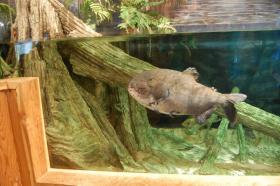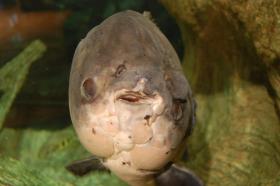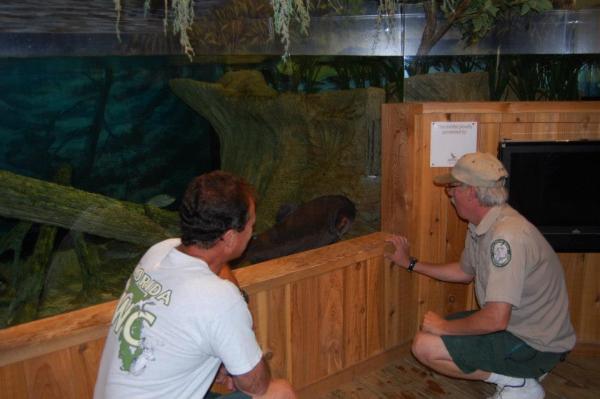- Listen to reporter Patricia Sagastume and the audio version of this story here.
In the piranha- infested waters of the Amazon, a baby Black Pacu, the vegetarian cousin of the flesh-eating fish survives capture. If it had nine lives, its next one was in a tropical aquarium in a Boca Raton seafood restaurant.
Weighing nearly one pound, the non-native Pacu was growing too big, too fast. Once again, the fish needed another home. The restaurant, The Ports of Call, was dismantling their aquariums so the Pacu was returned to its original owner.
“I didn’t want to just kill him or dump him in the canal but I didn’t have a tank to put him in,” says Charlie Holland, the retired pet storeowner of the Fins, Furs and Feathers.
Plus, there was something strange about the fish. It’s face looked like a Frankenstein version of itself.
“He used to spook and run into the end of ten foot long tank. That battering distorted its face,” said Holland.
With a bashed-in face, the fish had an even less marketable chance of being re-sold so Holland did what he thought he should. He called authorities. After all, the Pacu was non-native species.
“Charlie did exactly what was right,” said Paul Shafland, former director of the Florida Fish and Wildlife Conservation Commission Non-Native Research lab.
“It’s illegal to release any non-native fish, at the very least it’s unwise.”
Soon, the Pacu was on its way to a special laboratory where scientists study, dissect and measure invasive fish species in South Florida’s canals.
For nearly forty years, Florida Fish and Wildlife Commission Non-Native Research lab adopted many unwanted fish. The purpose of the lab is to provide fish strategies to protect native fish and their habitats from exotics like the Pacu.
But the lab officially closed April 30th and the new place, which is located in Boynton Beach, has no laboratory facilities.
Once again, it seemed the Pacu’s days were numbered but that was hardly the case.
The South Florida Science Museum wanted to adopt Igor but the aquarium they built was too small. Fortunately, the Loxahatchee River Center in Jupiter, which was temporarily housing Igor, decided to make it permanent.
“He stole the show. It use to be our turtles. But when people walk into the center and see him they go whoa, because he’s so big,” says Jocelyn O’Neill, the environmental education coordinator for the Loxahatchee River District.




No comments:
Post a Comment